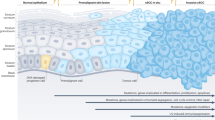Abstract
Cancer stem cells (CSCs) in most human tumors are commonly identified and enriched using similar strategies for identifying normal stem cells, including flow cytometry assays for side population, high aldehyde dehydrogenase (ALDH) activity, and CD133 positivity. Thus, development of a method for isolating a specific cancer using cancer-specific characteristic appears to be potentially important. Here, we reported extremely high Lgr5 levels in the specimen from skin squamous cell carcinoma (SCC) in patients. Using SCC cell line A431, we detected high Lgr5 and CD133 levels in ALDH-high or side population from these cancer cells. To figure out whether Lgr5 is a marker of CSCs in SCC, we transfected A431 cells with a Lgr5-creERT-2A-DTR/Cag-Loxp-GFP-STOP-Loxp-RFP plasmid and purified transfected cells (tA431) based on GFP by flow cytometry. 4-Hydroxytamoxifen (4-OHT) was given to label Lgr5-positive cells with RFP, for comparison to GFP-positive Lgr5-negative cells. Lgr5-positive cells grew significantly faster than Lgr5-negative cells, and the fold increase in growth of Lgr5-positive vs Lgr5-negative cells is significantly higher than SP vs non-SP, or ALDH-high vs ALDH-low, or CD133-positive vs CD133-negative cells. Moreover, in Lgr5-negative population, Lgr5-positive re-appeared in culture with time, suggesting that Lgr5-positive cells can be regenerated from Lgr5-negative cells. Furthermore, the growth of tA431 cells significantly decreased upon a single dose of diphtheria toxin (DT)/4-OHT to eliminate Lgr5-positive cell lineage, while multiple doses of DT/4-OHT nearly completely inhibited tA431 cell growth. Taken together, our data provide compelling data to demonstrate that Lgr5-positive cells are CSCs in skin SCC.






Similar content being viewed by others
References
Rahimi S. Squamous cell carcinoma of skin: a brief review. Clin Ter. 2013;164:143–7.
Petersson M, Niemann C. Stem cell dynamics and heterogeneity: implications for epidermal regeneration and skin cancer. Curr Med Chem. 2012;19:5984–92.
Perez-Losada J, Balmain A. Stem-cell hierarchy in skin cancer. Nat Rev Cancer. 2003;3:434–43.
Nagata T, Sakakura C, Komiyama S, Miyashita A, Nishio M, Murayama Y, et al. Expression of cancer stem cell markers CD133 and CD44 in locoregional recurrence of rectal cancer. Anticancer Res. 2011;31:495–500.
Fang DD, Kim YJ, Lee CN, Aggarwal S, McKinnon K, Mesmer D, et al. Expansion of CD133(+) colon cancer cultures retaining stem cell properties to enable cancer stem cell target discovery. Br J Cancer. 2010;102:1265–75.
Shi C, Tian R, Wang M, Wang X, Jiang J, Zhang Z, et al. CD44+ CD133+ population exhibits cancer stem cell-like characteristics in human gallbladder carcinoma. Cancer Biol Ther. 2010;10:1182–90.
Ottaiano A. Finding markers for cancer stem cells in renal cell carcinoma: looking beyond CD133. Cell Cycle. 2010;9:4431.
Ma S, Chan KW, Lee TK, Tang KH, Wo JY, Zheng BJ, et al. Aldehyde dehydrogenase discriminates the CD133 liver cancer stem cell populations. Mol Cancer Res. 2008;6:1146–53.
Wang J, Sakariassen PO, Tsinkalovsky O, Immervoll H, Boe SO, Svendsen A, et al. CD133 negative glioma cells form tumors in nude rats and give rise to CD133 positive cells. Int J Cancer. 2008;122:761–8.
Takubo K, Ohmura M, Azuma M, Nagamatsu G, Yamada W, Arai F, et al. Stem cell defects in ATM-deficient undifferentiated spermatogonia through DNA damage-induced cell-cycle arrest. Cell Stem Cell. 2008;2:170–82.
Duester G. Families of retinoid dehydrogenases regulating vitamin a function: production of visual pigment and retinoic acid. Eur J Biochem. 2000;267:4315–24.
Magni M, Shammah S, Schiro R, Mellado W, Dalla-Favera R, Gianni AM. Induction of cyclophosphamide-resistance by aldehyde-dehydrogenase gene transfer. Blood. 1996;87:1097–103.
Armstrong L, Stojkovic M, Dimmick I, Ahmad S, Stojkovic P, Hole N, et al. Phenotypic characterization of murine primitive hematopoietic progenitor cells isolated on basis of aldehyde dehydrogenase activity. Stem Cells. 2004;22:1142–51.
Hess DA, Craft TP, Wirthlin L, Hohm S, Zhou P, Eades WC, et al. Widespread nonhematopoietic tissue distribution by transplanted human progenitor cells with high aldehyde dehydrogenase activity. Stem Cells. 2008;26:611–20.
Hess DA, Meyerrose TE, Wirthlin L, Craft TP, Herrbrich PE, Creer MH, et al. Functional characterization of highly purified human hematopoietic repopulating cells isolated according to aldehyde dehydrogenase activity. Blood. 2004;104:1648–55.
Hess DA, Wirthlin L, Craft TP, Herrbrich PE, Hohm SA, Lahey R, et al. Selection based on CD133 and high aldehyde dehydrogenase activity isolates long-term reconstituting human hematopoietic stem cells. Blood. 2006;107:2162–9.
Liu Y, Jiang X, Zeng Y, Zhou H, Yang J, Cao R: Proliferating pancreatic beta-cells upregulate ALDH. Histochem Cell Biol 2014
Zhang L, Wang L, Liu X, Zheng D, Liu S, Liu C. ALDH expression characterizes G1-phase proliferating beta cells during pregnancy. PLoS ONE. 2014;9:e96204.
Silva IA, Bai S, McLean K, Yang K, Griffith K, Thomas D, et al. Aldehyde dehydrogenase in combination with CD133 defines angiogenic ovarian cancer stem cells that portend poor patient survival. Cancer Res. 2011;71:3991–4001.
Ma I, Allan AL. The role of human aldehyde dehydrogenase in normal and cancer stem cells. Stem Cell Rev. 2011;7:292–306.
Kinzel B, Pikiolek M, Orsini V, Sprunger J, Isken A, Zietzling S, et al. Functional roles of Lgr4 and Lgr5 in embryonic gut, kidney and skin development in mice. Dev Biol. 2014;390:181–90.
Haegebarth A, Clevers H. Wnt signaling, Lgr5, and stem cells in the intestine and skin. Am J Pathol. 2009;174:715–21.
Muzumdar MD, Tasic B, Miyamichi K, Li L, Luo L. A global double-fluorescent Cre reporter mouse. Genesis. 2007;45:593–605.
Xiao X, Chen Z, Shiota C, Prasadan K, Guo P, El-Gohary Y, et al. No evidence for beta cell neogenesis in murine adult pancreas. J Clin Invest. 2013;123:2207–17.
Author information
Authors and Affiliations
Corresponding author
Additional information
Shunli Liu and Zhenyu Gong contributed equally to this work.
The Publisher and Editor retract this article in accordance with the recommendations of the Committee on Publication Ethics (COPE). After a thorough investigation we have strong reason to believe that the peer review process was compromised.
An erratum to this article can be found online at http://dx.doi.org/10.1007/s13277-017-5487-6.
About this article
Cite this article
Liu, S., Gong, Z., Chen, M. et al. RETRACTED ARTICLE: Lgr5-positive cells are cancer stem cells in skin squamous cell carcinoma. Tumor Biol. 35, 11605–11612 (2014). https://doi.org/10.1007/s13277-014-2488-6
Received:
Accepted:
Published:
Issue Date:
DOI: https://doi.org/10.1007/s13277-014-2488-6




